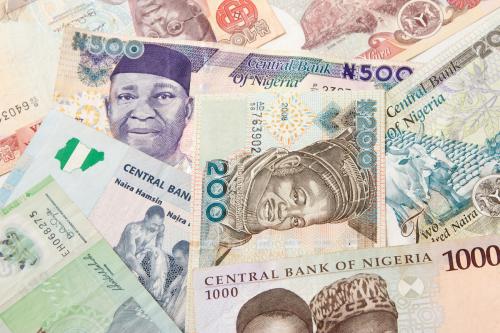Before the coronavirus outbreak, our article in Theoretical Economics demonstrated that the debt-to-GDP ratios of several African countries were nearing unsustainable levels. Unfortunately, this debt burden has escalated as African nations borrow more to address their development challenges, placing strain on their fiscal balance sheets. According to a 2023 report by the U.N. Economic Commission for Africa, the average debt-to-GDP ratio for the entire continent is projected to rise to 63.5% in 2023.
The escalating debt levels in Africa are prompting concerns that repayment may not only constrain economic performance but could become virtually impossible for many African countries. This raises a crucial question: At what point does debt cease to be productive and instead start to impair a country’s economic performance?
Debt Laffer Curve
Economic theory suggests that reasonable levels of debt contracted by developing countries can enhance their economic growth. In the early stages of development, countries often have limited capital stocks and may encounter investment opportunities with higher rates of return compared to advanced economies. If the debt is allocated to productive investments and is not affected by macroeconomic instability, absorptive capacity constraints, policies that distort economic incentives, or significant adverse shocks, it should contribute to increased growth and enable timely debt repayments.
Paul Krugman, however, has suggested that high levels of accumulated debt may be counterproductive, leading to low growth. Drawing on “debt overhang” theories (a situation where high debt levels result in efficiency losses), Krugman argues that if there is an expectation that future debt will exceed a country’s repayment capacity, anticipated debt-service costs can deter both domestic and foreign investment, thereby impeding growth. This argument reflects the debt “Laffer Curve,” which suggests that larger debt burdens are typically associated with lower probabilities of debt repayment.
Debt and inequality
Aside from enhancing economic growth, governments may choose to leverage debt to invest in health care, education, and other social infrastructure as a means to narrow income inequality in society. However, similar to the debt Laffer Curve, high and unsustainable levels of debt can inadvertently worsen inequality. This can occur through a number of channels.
First, the increased taxation necessary to service debt disproportionately burdens lower-income households, as they lack the means to offset tax burdens like wealthier individuals can. Second, high debt levels crowd out private sector investment, constraining opportunities for economic mobility, while higher interest rates on government bonds divert funds from crucial public investments, widening the wealth gap further. In addition, cuts to social programs, often enacted to manage debt, disproportionately impact disadvantaged groups reliant on these services. Lastly, excessive debt can lead to currency devaluation and inflation, disproportionately impacting the purchasing power of low-income individuals. Overall, mismanaged or excessive public debt not only strains public finances but also exacerbates income inequality by imposing disproportionate financial burdens on the disadvantaged and hindering their access to essential services and economic opportunities.
While current debate and research on debt offers valuable policy insights, it overlooks the direct impact of debt on income inequality in Africa. Additionally, there is limited understanding of whether the relationship between debt and income inequality follows a nonlinear pattern. The scarcity of long-term time series data on income inequality has resulted in limited empirical research on the distributional effects of Africa’s rapidly increasing debt burden.
Our recent paper in Applied Economics and Finance aims to address this gap in the literature by investigating the direct effects of debt on inequality and exploring whether the debt-income inequality link in Africa exhibits threshold-specific behavior. Based on data from 24 African countries,1 we use three different measures of income inequality (Gini coefficient, the Palma ratio, and the Atkinson index) and two debt thresholds (government gross debt and external debt stock, both measured as percentages of GDP) to carry out our analysis. Our control variables are inflation, trade openness, human capital, population growth and real GDP per capita.
Our analysis suggests that the relationship between government debt and inequality is intrinsically nonlinear, where the precise effect of government debt is conditioned on whether the debt is below or above the threshold value of 34.7% debt to GDP. Our findings also reveal that government debt is negatively associated with income inequality for countries where the government debt level is at most 34.7%. For countries with debt levels below the threshold value of 34.7% debt to GDP, a unit-percentage rise in government debt decreases the Gini coefficient by 0.0011%. However, when countries operate above the threshold, a unit-percentage rise in government debt increases the Gini coefficient by 0.000059%.
The primary implication of our findings is that while public debt generally reduces income inequality, unchecked debt accumulation beyond certain thresholds fails to decrease income inequality. This implies that the income inequality-reducing effect of public debt largely holds at lower levels of debt-to-GDP ratio. Moreover, this evidence is robust across various indicators of income inequality and debt. From a policy perspective, this would mean that while public debt may serve as an additional financing option for African countries, unchecked debt accumulation could also contribute to increasing inequality.
Heavily indebted countries are in urgent need of relief to avoid defaults. Fortunately, multilateral institutions have stepped in to assist developing economies in mitigating the adverse effects of the pandemic and alleviating their debt burdens. Indeed, measures that reduce unsustainable debt are crucial for Africa’s development, as they not only directly lower Africa’s debt stock but also indirectly mitigate further increase in the region’s high income inequality.
-
Acknowledgements and disclosures
The views expressed in the note are those of the authors and should not be attributed to any institutions they are or have been affiliated with currently or in the past.
-
Footnotes
- The 24 countries are Benin, Botswana, Burkina Faso, Chad, Republic of Congo, Cote d’Ivoire, Egypt, Gabon, Gambia, Ghana, Guinea–Bissau, Madagascar, Malawi, Mali, Mauritania, Mauritius, Niger, Nigeria, Rwanda, Senegal, Sierra Leone, South Africa, Tunisia, and Uganda.
The Brookings Institution is committed to quality, independence, and impact.
We are supported by a diverse array of funders. In line with our values and policies, each Brookings publication represents the sole views of its author(s).









Commentary
The impact of public debt on income inequality in Africa
April 1, 2024